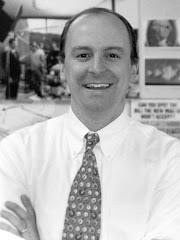At any rate, after the bank president Kirk Briden kicked off the meeting in fine style (See “Part I”), he turned the mic over to Lane Alpert, Senior Vice President. Lane talked about the commercial side of the bank by opening with a short anecdote about Auguste Renoir. (Art history majors, rejoice!)
Apparently Renoir suffered from terrible arthritis during the final twenty years of his life; it was so bad that his gnarled, pain-stricken hands could barely hold a paintbrush.
When asked by a friend why he continued to paint while he suffered so greatly, Renoir replied,
“The pain passes, but the beauty remains.”Lane tied this quote to his team’s hard work and creative approach to banking. It’s not easy, but certainly worth the effort. He also quipped that bankers’ hours for his group meant 11-12…(long pause)…hour days. Nice.
And to top it off, Lane concluded his remarks by going back to the Renoir quote. Very poignant. Very symmetrical. Sort of like a Hemingway chapter. Bravo.
Even when the vertically-challenged CFO, Bruce Phelps got up behind the lectern to start his portion of the program, he opened with humor by saying, “Yes, I am standing up.” Laughter ensued. Undoubtedly Bruce had the toughest assignment of the night because he had to read all the legal disclaimers, review some key financial information and handle the Robert’s Rules of Order stuff. But he even joked about trying to make his part of the presentation shorter, but the lawyers wouldn’t have any of it. Another smile, dare I say a laugh from the crowd.
Finally, Kirk Briden once again stepped up to the microphone and he asked all 37 of the bank employees to stand while the shareholders gave them a rousing ovation. But he didn’t stop there. Kirk also acknowledged the support and sacrifice made by the employees’ spouses and significant others (who were also in attendance).
Again, it was THE best banking presentation I had ever seen. Kirk, Lane and company took a potentially dull discussion of data and turned it into a decidedly dynamic discourse. That’s dynamite.
Interesting sidebar: After the meeting I had no less than three people came up to me and ask if I had given the presenters speech coaching. I had not. I wished I could have taken credit for their speeches that night because it probably would have lead to additional business for me.
I guess I’ll have to find another group of bank officers that need help jazzing up their presentations. Know anybody who fits this description? Let me know.
Time to Hit Your Stride…
Your Turn #1: Who are the unsung heroes of your organization that need to be recognized publicly? How can you honor them in your next presentation?
Your Turn #2: Many people might think that banking and humor don’t mix. I think they mix quite well. Where can you add a little relevant, appropriate humor to your business communication?
Happy speaking,
Steve Hughes
Speaker - Trainer - Sudden Banking Enthusiast
